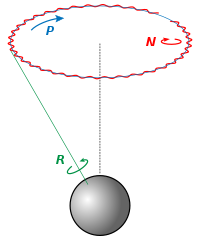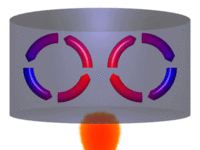|
Vikidia currently has 4,621 articles. Improve it! |
|
Join Vikidia: create your account now and improve it! |
Earth
| Mercury • | Venus • | Earth • | Mars • | Jupiter • | Saturn • | Uranus • | Neptune |
The Earth is our planet. At the moment, it's the only planet with life because it has a dense atmosphere of nitrogen and oxygen. The predominant color is the blue because it is three-quarters covered by oceans. It is believed to have formed about 4,600 million years ago.
Description[edit | edit source]
The Earth is the third planet from the Sun in the Solar System. It is orbiting between Venus and Mars at an average distance of 149.6 millions km. The Earth also has one satellite, which is the Moon and has an equatorial diameter of 12,756 km across it.
The structure of the Earth[edit | edit source]
The inside of the Earth is separated in five layer:
- inner core, solid
- outer core, liquid
- mantle, viscous
- asthenosphere, the outer part of the Mantle
- crust, divided in two parts: oceanic and continental crust
Above the fifth layer of the Earth inner structure comes the atmosphere, whose density decreased with the altitude above the Earth surface.
The movements of the Earth[edit | edit source]
Revolving motions[edit | edit source]
The Earth has two movements: it rotates around its axis and revolves along its orbit around the Sun.
- The rotation is the movement that the Earth makes in 24h. In this day, the Earth spins on itself: it revolves around its own axis.
- The orbital revolution is the movement that the Earth makes around the Sun and which lasts for 365 days and 6 hours (a bit more than a standard year: this is the reason why every four years is a leap year in our calendar).
Millennial motions[edit | edit source]
The millennial motions are the movement that is made in a very long time (ex: 1,000 years).
- precession: due to shifting of the axis on the rotation
- nutation: the Earth makes small oscillations, the duration is of 18 years and the cause is the moon's gravitational attraction.
Internal motions[edit | edit source]
The internal motions (convective motions) is a type of transmission of energy in the fluids.
In this movement:
- The cold fluids go down;
- Under there is a source of heat so that the fluid's heat;
- As they are warmer, the fluids go up again and heat the upper part a bit;
- After having heated the upper part, it is colder;
- The whole cycle gets repeated again.
The Moon[edit | edit source]
The Earth has one satellite, the Moon.
| Astronomy Portal — All articles about astronomy! |



